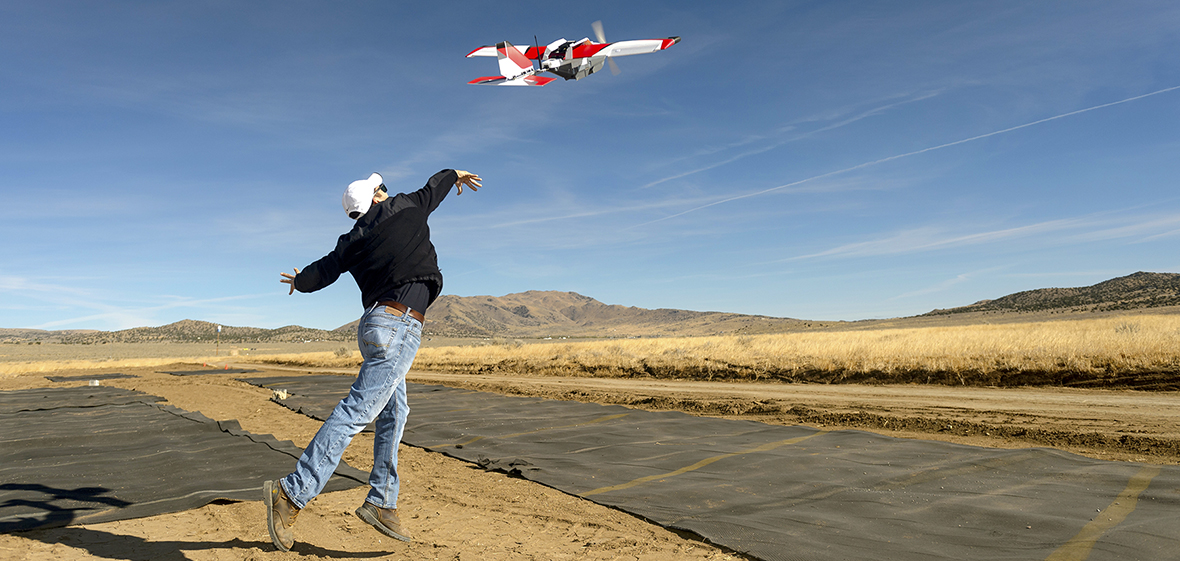With the easing this month of FAA rules governing the flying of drones, the low-altitude airspace will become increasingly more crowded, and potentially more dangerous. The University of Nevada, Reno has partnered with NASA to work toward a comprehensive air traffic management plan that the FAA could use to regulate and keep that airspace safer.
The first-ever testing of NASA's air traffic management platform concepts, with drones flying beyond line of sight, were held at the end of October at the NUANCE Laboratory, the University and NASA's collaborative work space for autonomous systems. Several aircraft flew up to a mile from the operators in several patterns at the end of one of the runways at the Reno-Stead Airport, simulating several real-world scenarios in the UAS Traffic Management research platform.
"Tests such as this can't be done anywhere else in the nation," said Warren Rapp, business director of NAASIC, the University's robotics and intelligent systems center. "With five aircraft flying in the same airspace accomplishing separate tasks, redirecting mid-task and being tracked by real radar systems as part of the UTM research platform using the software being developed, it's exciting to see what we set out to do several years ago making such good progress."
The NUANCE Lab, located in the terminal at the Reno Stead airport, hosted the NASA exercises during a three-week period with a dozen partners flying a variety of aircraft and testing software that not only tested real-time operations, but simulated various wind and weather conditions, emergency flight operations and dynamic re-routing capability that allows an unmanned airborne vehicle to request flight plan changes. This function allows operators to update their missions in response to either changing airspace conditions or new mission objectives.
The aircraft in the October tests operated using NASA's software, with a direct network connection from the NUANCE Lab to NASA Ames Research Center in Silicon Valley, communicating through this command center.
The traffic management system being researched is essentially a network on which autonomous aircraft would communicate to one another to avoid crashes. This round two of traffic management research and testing by NASA, in collaboration with the Federal Aviation Administration, was used to obtain information to further refine and develop their air traffic management research to safely enable large-scale UAS operations in the low-altitude airspace.
"Eventually there will be a smart air space where the system will mitigate most of the risks that are involved in flying in the airspace up to about 500 feet above ground," Rapp said.
At a demonstration during the three-week-long research operations, five aircraft flew at varying altitudes, one looking for a hypothetical lost hiker, one covering a sporting event, one monitoring wildlife and another surveying for environmental hazards. Two fixed-wing aircraft, one with a 14-foot wingspan, and three rotor propelled aircraft were operated from separate locations at the north end of the airport, with one runway staying open for regular airport use.
"It's wonderful to see how far we've come with this project in a relatively short time," Richard Kelley, chief engineer for NAASIC said. "NASA has put together an aggressive program to build a safer airspace for low-altitude flights and it's great to be one of the partners."
Kelley is one of several scientists working with NASA Ames Research Center who have been a part of the air traffic management project since it began in 2014.
"For these tests, we provided field support and access to the lab," he said. "Our research role was small this time, our participation was part of our grant to support testing such as this, part of a team with NASA, the State of Nevada and the Nevada Institute of Autonomous Systems."
Through the NUANCE Lab, the University and NAASIC is working with the Governor's Office of Economic Development to promote Nevada's innovation-driven economy. As the University partners with aerospace companies both large and small, the NUANCE Lab fosters public-private partnerships in Nevada to use the lab to strengthen and broaden Nevada's aerospace industry, enabling Nevada scientists and engineers to test advanced aerospace concepts with one of the leading aeronautical research centers in the world.












